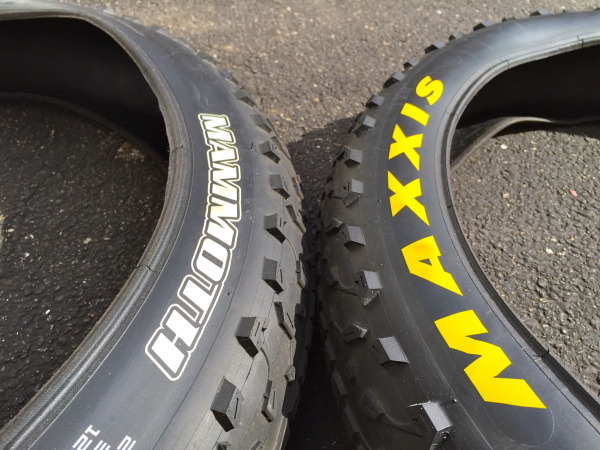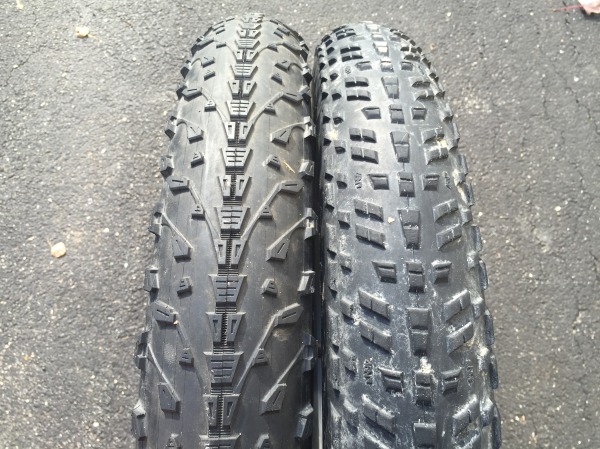As the fatbike tire market continues to grow, more and more big name tire makers are getting into the game. This past summer, Maxxis threw its hat into the ring and unveiled their new fatbike tire, the Maxxis Mammoth (along with a 29+ tire, the Chronicle, which was covered here). Gomez gave you a first look of the tire back in July and now I’m here to give you the lowdown on how they ride. But first, some more details . . .
The tire is labeled at a 26×4.00 and it measures a true 4.0 inches from the farthest outside points, which is edge lug to edge lug (on a Holy Rolling Darryl at 10 PSI). For comparison, the Hüsker Düs that I was previously running (also a claimed 26×4.0 tire) measures only 3.78” from the widest point, which are the sidewalls.
Upon first look, you can tell this is going to be a fast tire that corners well. The tread pattern has an overall chevron shape similar to the Hüsker Dü and Dillinger. However, the similarities end there. The Mammoth tread has much more pronounced edge (6 mm high) and side (4 mm high) knobs compared to its lower, more widely spaced center tread (2 mm high) with all knobs having some amount of sipping on them. Obviously, the edge and side knobs help with cornering and the lower profile center help reduce rolling resistance. This configuration of taller edge/side lugs and much lower center tread also gives the Mammoth a more squared off profile when compared to the HuDus, especially under load at lower PSI. Also noticeable upon first glance are the beefy sidewalls. Maxxis bills this as EXO Protection technology, which means they are reinforced with cut and abrasion resistant fabric (coming off 120 tpi Hüsker Düs, this was a welcome sight). The Mammoth will be available in both 120 tpi and 60 tpi versions with the EXO sidewalls only available in the 120 tpi carcass.
The tires weighed in at 1291g/1293g, which is about 100 grams per tire more than the 120 tpi Husker Dus (the ultralight variety). That 100 grams per tire is easily accounted for in EXO sidewalls as well as the bigger outer lugs. Whether the weight gain is worth it, is really up to rider preference and what you are looking for in a tire (sidewall durability vs. weight).
On the trails, the Mammoth is indeed fast and corners very well. It handles very predicatively and those beefy side lugs hook up nice when leaned into. There was a slight amount of autosteer and I think this was mainly due to the transition from the widely spaced, low profile center knobs to the much bigger side/edge lugs (i.e., the squared off profile I mentioned earlier). The best I can describe it is a slight squirm. I found that I could remedy some of the autosteer by bumping up the PSI a little above where I run my HuDus (9 psi vs 7 psi). During my testing, I also encountered some slightly moist conditions, and the wider spacing on the tread really helps prevent the tire from caking up like the HuDus tend to do. Even when they started to hold a little mud, the side and sedge knobs were big enough to still hook up. However, with the lower middle knobs, traction was really sketchy at times on wet roots and rocks. Overall, these are definitely dry condition tires and should really be viewed as such.
After a few rides with tubes, I decided to set the Mammoth up tubeless. The EXO Protection sidewalls, as well as a nice even looking bead, had me optimistic that these would set up pretty easily. Indeed, a quick blast with a compressor had the beads popped into place and after a few shakes, the bead interface didn’t leak any air and there was absolutely no weeping of sealant from the sidewalls. Out on the trails, the ride improvement was immediately noticeable. The tires seemed to grip even better, especially in the corners, roll smoother, and interestingly, the autosteer was slightly reduced.
We got some early season snow so I decided to take the Mammoth out for a few spins. I wasn’t expecting great performance due to the low profile tread pattern, but after I got out on the trail, most of those fears were laid to rest. They provided adequate traction and didn’t pack up with any snow. With that said, we’re only talking a few inches of snow and even that had been packed down so I’m not ready to give the Mammoth snow tire status. However, under the right conditions (well groomed), I think it would perform just fine.
Overall, I really liked the Mammoth. I think it’s an excellent dry conditions tire, especially for those looking to reduce rolling resistance but not give up much in the way of cornering traction. The added bonus of the EXO Protection sidewalls and easy tubeless setup make them a contender if you’re in the market for new hard pack condition tires. Based on the Gnomish scale of tire rideability, I’d rate the Mammoth a 4 gnomes out of 5 for dry conditions, 2.5 out of 5 for winter, and a 2 out of 5 for wet conditions.
For more info on Maxxis tires visit – http://www.maxxis.com/tires/bicycle
 FOLLOW US ON INSTAGRAM #fatbikedotcom
FOLLOW US ON INSTAGRAM #fatbikedotcom








Any idea if a tubeless ready version is in the works?
The reason I ask is Maxxis’s website says using any type of sealant voids the warranty on their non-TR(tubeless ready) tires. That coupled with the potential blistering problem that affects some of their tires makes a non-TR version of this tire less than what it’s potential could be.
I’ve been riding the 120-TPI EXO’s for the past month and I concur with this review.
I’ve put >200 miles on what could be called groomed trails (by snowmobiles and skiers) and >50 miles on pavement (getting to/from the trail head). I ride in Ottawa Canada so the conditions have varied from ice/gravel, hard and soft packed snow, to a few inches of powder. I don’t normally ride on technical or ungroomed trails so I can’t comment on the “off-piste” performance.
For my first few rides I had the tires at 8 psi and they were slow and quite bouncy (probably thanks to those EXO sidewalls). I bumped the pressures up, to 20 PSI on the rear and 12 PSI for the front, and the performance improved dramatically. They still smooth out the trail and get the traction I want but now roll much more efficiently.
The float is really good (I make the same dent in the trail as the XC skiers). They don’t seem to be bothered by the depth of the loose snow (as long as the base is firm). I find they have good grip (no slippage) but they still shed the snow/slush). They track really well so riding in snowmobile ski tracks or backtracking isn’t a problem.
The minimalist side lugs means they can go a bit sideways in the loose stuff. I agree with the reviewer that if you are planning on breaking a lot of trail, the tread on these is not suitable for the purpose (note: the manufacturer markets them as “hard pack” tires so they are not trying to mislead the consumer).
Overall these tires are a great fit for my type of winter riding…2+ hours on groomed snow covered trails.
Disclosure: these tires came with my fat bike; and I read the original review before my purchase so I knew what I was getting.
These tires rip in the dirt!
20lbs pressure front and rear and they ride like they are 2.4 tires.
Less bounce, at a higher pressure, than the Surlys they replaced and they corner like running backs.
Looking forward to trying them on the snow.
But how are they on a fat ebike?